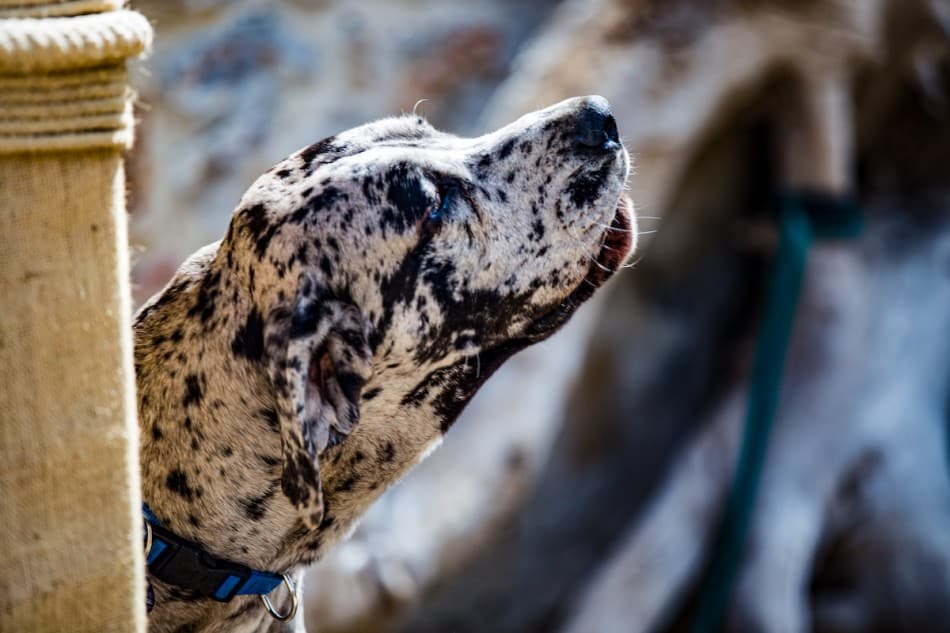
Great Danes are a large dog with a large bark to match, but getting them to stop barking when you want them to can be tricky if you don’t have a strong understanding of the history of Great Danes or how dogs use barking to communicate.
So how do you stop your Great Dane from barking? Here are some of the ways you can go about stopping your Great Dane from barking:
- Learn training methods to teach a Great Dane to stop barking
- Learn about devices that can help prevent a Great Dane from barking too much
- Learn about debarking and why it is not a good solution for barking
Excessive barking is a problem that’s easier to solve in puppyhood, but it can be addressed in a Great Dane at any age. Read on to find out more about how to keep your Great Dane from barking too much.
Training Solutions for Excessive Barking
The best solution for avoiding a Great Dane that barks too much is to work with the dog a lot i.e. multiple times a day when they are a puppy.
Training a puppy is crucial not only to make sure that it understands basic human commands but also to expose it to a wide variety of sensory stimuli in order to desensitize it and prevent phobias later in life caused by unfamiliarity with situations or objects. Training also helps work off excess energy, which can manifest as excessive barking in adolescence.
Socializing a puppy thoroughly from the time it has its first protective vaccinations on is the best way to prevent barking because it reinforces a dog’s natural sociability and friendliness, and it also keeps the dog from becoming bored and lonely.
Great Danes are already a friendly breed, and when they have lots of social interaction, they truly become gentle giants.
For older dogs that have developed a problem with barking, a different tact has to be used. Counterintuitively, one of the best ways to teach a dog to be quiet is to teach it the “Speak” command.
Once you teach a dog the concept of “Speak,” it is easier to teach a dog the concept of “Quiet” (the counter command to speak).
How to Teach Speak and Quiet to Great Danes
Here is the process for teaching your dog “Speak” and “Quiet” (Note: You will need a training clicker and a bag of small treats for this exercise):
- Wait for the dog to already be barking excitedly, say “Speak”, click the clicker, and give the dog a treat. When you have the dog’s attention, say “Speak” again. Wait for the dog to bark, click the clicker, and give the treat while praising the dog.
- Repeat this process until the dog begins to bark after the command and appears to understand that the word “Speak” and the act of barking are directly related. This may take several attempts depending on how quickly your individual dog catches on.
- Once the dog understands “Speak,” repeat the process but by rewarding silence with treats. Gradually increase the periods of silence required to obtain the treat after being commanded to be “Quiet,” similar to gradually lengthening the time on a “Stay” command.
Training a dog is basically a matter of teaching them basic concepts in a human language.
It is best to teach a Great Dane several basic commands (sit, come, stay, down, heel) as a puppy not only because it teaches the dog those useful skills, but also because it teaches the dog to generally listen to you and respect you more.
This is why basic training for a dog as a puppy can make corrective training commands like “Speak” and “Quiet” much easier. If you’re not sure how to teach these essential commands, make sure to take a look at our article here.
Once your dog understands that “Speak” equals barking and “Quiet” equals your request for no barking, it is much easier to correct the dog whenever it barks too much.
Unfortunately, this kind of training does not help excessive barking when the owner is not at home. For this scenario, anti-barking devices and anti-bark collars are usually a better option, along with reduced negative stimulation and increased positive stimulation.
Device Solutions for Excessive Barking
If a Great Dane barks too much while you are away, there are several devices you can try to fix the problem.
These solutions will vary depending on what is causing the barking problem to begin with–for dogs left at home alone, it is either boredom or territoriality.
Here are some methods you can try:
- Stimulation toys: Dog toys such as treat puzzles and other enrichment objects can help keep a dog occupied while their owner is away. This both helps to keep the dog quiet and also keeps them from becoming bored or lonely.
- Anti-barking device: Electronic anti-barking devices are a good choice for backyard Great Danes who have become excessive barkers during the day while their owners are away at work or school.
- Anti-bark collar: Anti-bark collars have enjoyed increased popularity as training devices due to their increasing levels of sensitivity and other technological improvements that have made them a more humane option. However, anti-bark collars (like prong collars) are still regarded as controversial in some circles.
- Privacy fence: If your Great Dane is barking too much during the day because of people walking back and forth that he/she can see, then you might want to consider getting a privacy fence to block a view of the street. This can dampen “guard barking” behavior in dogs by cutting down on constant visual stimulation.
Great Danes and Excessive Barking
Unlike some breeds of dog, Great Danes are not known for being neurotic or excessive barkers.
However, due to their unique size, there are many downsides to having a Great Dane that barks too much:
- Great Danes have a bark that is very loud, deep, and far-carrying. Great Danes usually don’t bark much, but once one starts to bark, people will be able to hear it down at the other end of the street.
- The size of Great Danes makes them an intimidating breed, and when paired with a loud booming bark, these dogs can be seen as very threatening by people that don’t know them personally.
- Excessive barking renders a Great Dane useless for guarding property since it becomes a “boy who cried wolf” scenario–nobody ever takes the dog’s warnings seriously because it barks all the time, rather than when there is an actual threat.
Excessive barking in any dog breed can be a serious problem due to neighbor complaints and general irritation to the dog’s human housemates, but because of their size, it is a much bigger problem when it occurs in Great Danes.
Debarking – An Extreme Option
Some people consider debarking as a way to stop a dog from barking, but debarking operations are not a good option for a number of reasons.
Here is why you should consider intensive training, anti-barking technology, exercise, and other methods rather than debarking:
- Debarking is an operation that does not even guarantee that the dog will stop barking.
- Debarking requests by owners are increasingly being denied by veterinarians who refuse to perform it because it is viewed as unnecessary and inhumane.
- Debarking is expensive and can lead to medical complications.
There are so many options available to help stop a Great Dane from barking that there really is no reason to consider debarking, but if you were, be aware that more and more vets will refuse to carry the procedure out.
Training Is the Best Solution to Stop a Great Dane from Barking
While there are plenty of tools that can help you stop your Great Dane from barking, training is the best solution because it helps to mitigate so many different kinds of barking.
Training not only stimulates your Great Dane mentally and desensitizes it to sensory stimuli that causes barking, but it also helps your dog to better understand what you want it to do.
By reinforcing your bond with your Great Dane through consistent and gentle training, you can eventually have a dog that is happy, calm, and (most importantly) quiet.


Hey Zach,
I have the most beautiful great dane. I’ve wanted a great danes for many many years before I was able to finally get one. He’s wonderful in every way. Someone is home with 24/7. He is never alone. The only problem I have with him, is his barking.It’s beyond bad. I have truly tried everything that I read, too get him to stop. Bark coller, cliker, commands which he’s grat at except with barking. Food treats, exercise, which he gets all of the time. He truuly has a wonderful life. But I cannot handle the barking….